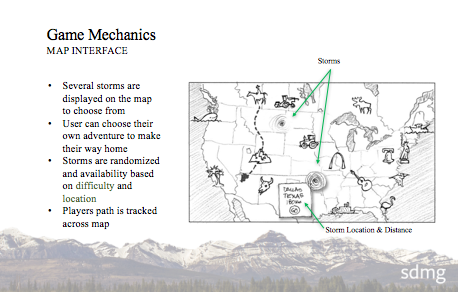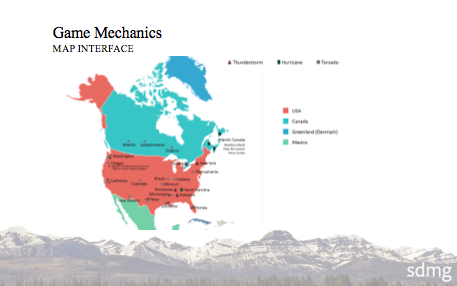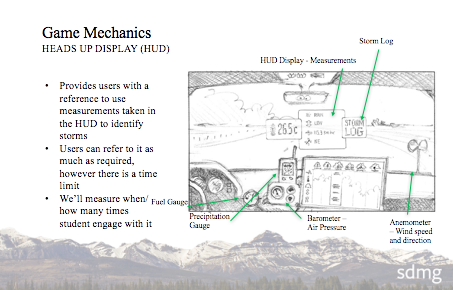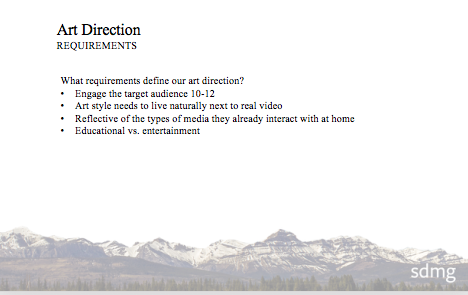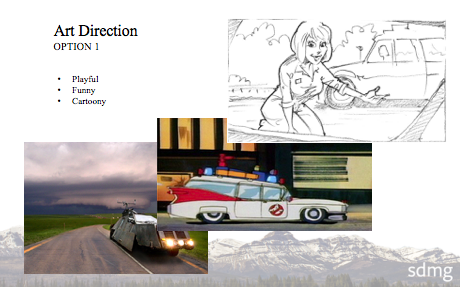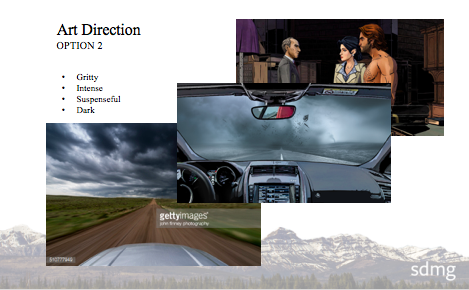The Design Process
Welcome to GBL International's design studio! Here, we'll walk you through our award winning game design process, which includes two key elements that create significant barriers to entry for other companies. First, is our international access to classrooms, where we engage with teachers and students throughout the game design process. Second, is our rapid game development cycle, which allows us to prototype, test, and release all within a 12 month timeline. In addition, we have significant intellectual property in the area of adaptive learning, which incorporates into game mechanics. GBLI is quickly emerging as the number one go-to for game-based learning resources!
Using one of our recent releases, Storm Chasers: Raging Skies, you'll see each step from conception of game-based learning idea to release! Before you delve into the design process we used to make this game, please take a few minutes to play it. Click the link below and use the login information to access the game. Storm Chasers: Raging Skies, login: ETEC522, password: ventureproject
Welcome to GBL International's design studio! Here, we'll walk you through our award winning game design process, which includes two key elements that create significant barriers to entry for other companies. First, is our international access to classrooms, where we engage with teachers and students throughout the game design process. Second, is our rapid game development cycle, which allows us to prototype, test, and release all within a 12 month timeline. In addition, we have significant intellectual property in the area of adaptive learning, which incorporates into game mechanics. GBLI is quickly emerging as the number one go-to for game-based learning resources!
Using one of our recent releases, Storm Chasers: Raging Skies, you'll see each step from conception of game-based learning idea to release! Before you delve into the design process we used to make this game, please take a few minutes to play it. Click the link below and use the login information to access the game. Storm Chasers: Raging Skies, login: ETEC522, password: ventureproject
Designed for Alberta’s grade 5 students in support of the Weather Watch science unit, this role-playing game transports students into the world of storm chasers, asking them to use various resources (e.g., weather balloon and thermometer) located on their vehicle to collect information regarding the weather phenomenon (i.e., identify the type of storm). The game uses real-time footage of storms across North America as players collect data, identify the type of storm, and report on it. The footage is overlaid with animated elements to emulate a first-person experience. Most importantly, Storm Chasers: Raging Skies has been designed with in-game assessment, which means the game is responsive to students' learning level. Outcomes are based on game mechanics that are scaffolded into game progress. The act of playing the game is informing the learning versus a student just coming across concepts. So, how is it designed? Tasks are purposefully embedded and integrated in the game’s design and framework so that specific knowledge and skill-based outcomes may be measured. To learn more, read evidence-centered_game_design_.pdf, Man-Wai Chu and Angie Chiang (2016).
*All images and descriptions released with permission of MindFuel, 2018
*All images and descriptions released with permission of MindFuel, 2018

Budget:
A typical game will cost $100,000 to develop and launch, developed over a 6 to 12 month cycle. Each game is focus-tested in classrooms to ensure learning outcomes are achievable.
A typical game will cost $100,000 to develop and launch, developed over a 6 to 12 month cycle. Each game is focus-tested in classrooms to ensure learning outcomes are achievable.

Step 1: Generate Game Concept
The game concept will be based on a particular grade or age group, unit of learning, and will be aligned to curricular learning outcomes. In this example, Storm Chasers: Raging Skies is developed for grade 5 students, in support of Alberta's program of studies in science for The Weather Unit. Much like a novel, the game concept is based on the player overcoming force(s) acting against him/her. In Storm Chasers, the player must overcome the force of the elements of the weather.
The game concept will be based on a particular grade or age group, unit of learning, and will be aligned to curricular learning outcomes. In this example, Storm Chasers: Raging Skies is developed for grade 5 students, in support of Alberta's program of studies in science for The Weather Unit. Much like a novel, the game concept is based on the player overcoming force(s) acting against him/her. In Storm Chasers, the player must overcome the force of the elements of the weather.
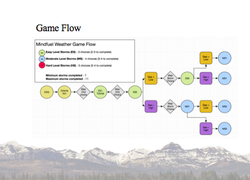
Step 2: Game Flow
Based on the game concept, the game flow must now outline the various elements that are acting against the player. The flow must follow rules of engagement that, when understood and applied, assist the player in achieving the desired outcome, which is overcoming the forces acting against him/her.
Based on the game concept, the game flow must now outline the various elements that are acting against the player. The flow must follow rules of engagement that, when understood and applied, assist the player in achieving the desired outcome, which is overcoming the forces acting against him/her.
Step 3: Game Mechanics & Assessment
This is the part the player/student is not necessarily aware. It's the assessment architecture. Tasks are purposefully embedded and integrated into the game’s design and framework so that specific knowledge and skill-based outcomes can be measured. Students cannot overcome the force, and therefore advance, until they've learned and applied the required learning outcome. To learn more about in-game assessment, read evidence-centered_game_design_.pdf, Man-Wai Chu and Angie Chiang (2016).
This is the part the player/student is not necessarily aware. It's the assessment architecture. Tasks are purposefully embedded and integrated into the game’s design and framework so that specific knowledge and skill-based outcomes can be measured. Students cannot overcome the force, and therefore advance, until they've learned and applied the required learning outcome. To learn more about in-game assessment, read evidence-centered_game_design_.pdf, Man-Wai Chu and Angie Chiang (2016).
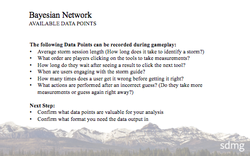
Step 4: SMEs (subject matter experts and information)
In Storm Chasers: Raging Skies, the Bayesian Network and subject matter experts were consulted and utilized. Not only does this provide real world relevance and virtual imaging, but also ensures accuracy and reliability of simulated weather conditions and situations.
In Storm Chasers: Raging Skies, the Bayesian Network and subject matter experts were consulted and utilized. Not only does this provide real world relevance and virtual imaging, but also ensures accuracy and reliability of simulated weather conditions and situations.
|
Step 5: Art Direction
This is a critical step in development and will greatly influence user acceptance. When designing an educational game, considerations must be given to age and level of learning. Every aspect of the character(s) is focus tested in classrooms to ensure the character will be accepted by the student. For instance, the gender of the character, the clothing and language dialect, and more are all focus-tested. If feedback includes students wanting the character to wear a 'blue' hat instead of a 'red' hat, or a particular language accent, then this feedback is incorporated into overall final design specifications. |
Focus Testing:
Focus-testing is an important part of the development process as it alerts the design team to any element that may need to be reconsidered. For instance, if learning outcomes are not achievable, due to overly complicated game mechanics, then adjustments need to be made. Likewise, if outcomes are too easily achievable, and students do not feel challenged, then the game will lose student interest. Typically, focus testing involves three or more skilled professionals to lead a guided in-classroom session to get feedback from students on all of the above steps. There is typically valuable feedback, which is reflected in changes or modifications before game release. The biggest challenge with focus testing is timing school board ethics approval to engage students in testing. Typically can take three months, but sometimes approval can take six months or more. If the latter is the case, then any further development is halted, then resumed post testing.
Focus-testing is an important part of the development process as it alerts the design team to any element that may need to be reconsidered. For instance, if learning outcomes are not achievable, due to overly complicated game mechanics, then adjustments need to be made. Likewise, if outcomes are too easily achievable, and students do not feel challenged, then the game will lose student interest. Typically, focus testing involves three or more skilled professionals to lead a guided in-classroom session to get feedback from students on all of the above steps. There is typically valuable feedback, which is reflected in changes or modifications before game release. The biggest challenge with focus testing is timing school board ethics approval to engage students in testing. Typically can take three months, but sometimes approval can take six months or more. If the latter is the case, then any further development is halted, then resumed post testing.
* GBL International is a fictional company created for the sole purpose of teaching about Game-Based Learning.

